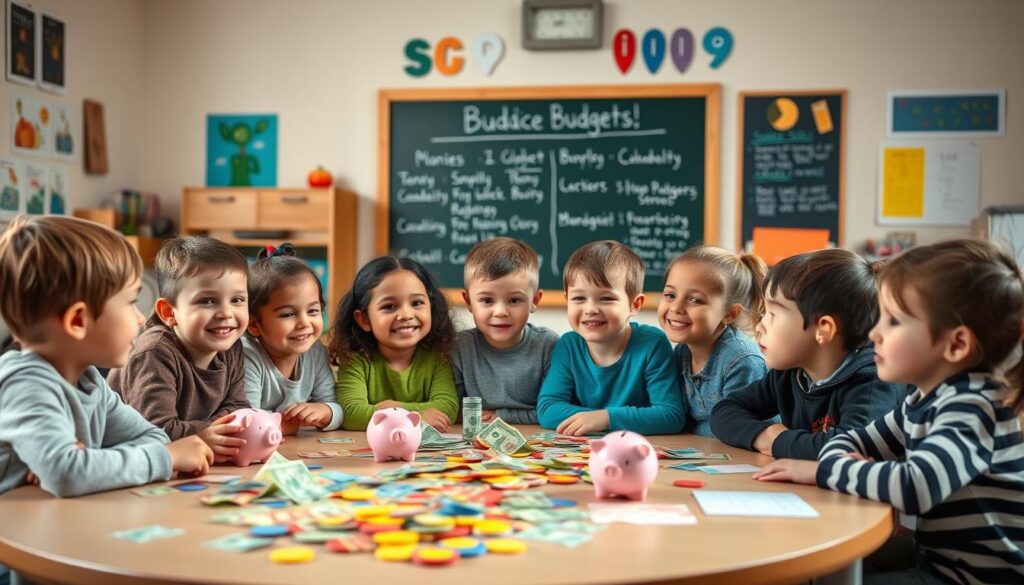Children start grasping money concepts as early as age two. Simple activities like playing store or counting coins help them understand value. These early lessons lay the foundation for financial literacy for kids, shaping their future money habits.
Teaching children to save isn’t just about piggy banks. Tools like 529 plans combine education savings with real-life lessons. They learn patience and responsibility while securing their future.
Everyday experiences, like lemonade stands, teach commerce basics. Kids see how effort turns into earnings. Balancing risk and reward becomes second nature with practice.
Start small. Use age-appropriate conversations to explain needs versus wants. Financial skills build confidence and emotional resilience, preparing them for life’s challenges.
Key Takeaways
- Kids begin understanding money concepts by age two.
- Early lessons shape lifelong financial habits.
- 529 plans teach saving while funding education.
- Real-world activities, like lemonade stands, reinforce money skills.
- Balance financial security with smart risk-taking.
How to Talk to Kids About Money: 2025 Parent’s Guide
The seeds of smart money habits are planted during everyday family moments. By weaving financial lessons into daily life, you help your child grasp concepts like saving, spending, and earning naturally.
Why Starting Early Matters
Research shows 72% of adults credit their parents as their primary financial influence. Begin teaching kids money basics in second or third grade when math skills develop. Early lessons stick:
- Ages 5–7: Identify coins and understand simple trades.
- Ages 8–10: Grasp saving for short-term goals (e.g., toys).
- Teens: Budget allowances and compare prices.
Making Money Conversations Routine
Normalize chats by tying them to real-life moments. Try these scripts:
«Let’s set aside $5 from your allowance this week. What would you like to save for?»
Use «money minutes»—quick check-ins during car rides or meals. For example:
- Compare prices at the grocery store.
- Discuss needs vs. wants before shopping trips.
Balance honesty with simplicity. A child doesn’t need to know mortgage details, but explaining home budgeting builds awareness.
Practical Ways to Teach Kids About Money
Money skills grow best through hands-on practice, not just lectures. Simple tools like a piggy bank or grocery trips turn abstract ideas into *lightbulb moments*. Research shows kids who handle physical money grasp concepts 40% faster.
The Power of a Piggy Bank
Upgrade the classic piggy bank with a three-jar system: Save, Spend, and Share. This visual teaching tool breaks money into clear purposes. For example:
- Save: Stash cash for a bike or game.
- Spend: Buy small treats guilt-free.
- Share: Donate to a cause they care about.

Kids with allowance systems develop 89% better budgeting skills. Celebrate milestones with progress charts—like coloring a thermometer for each $10 saved.
Grocery Store Lessons
Turn errands into lessons. Play «Price Hunt» by comparing two cereal boxes. Ask: *»Which gives more per ounce?»* Middle schoolers can calculate unit prices. For younger kids, try «This OR That» choices: *»Do we buy cookies or fruit this week?»*
Coupon clipping becomes a math game. Give them $5 off coupons and challenge them to stretch it. These real-life exercises boost critical thinking in 78% of children.
Using Allowances to Build Money Habits
Structured allowances teach kids more than just spending—they shape lifelong habits. Research shows children with clear allowance systems develop 30% better financial outcomes. Start with three jars: Save, Spend, and Share.

The Spend-Save-Share Method
Divide each allowance into percentages: 50% for savings, 30% for spending, and 20% for sharing. This visual system teaches balance. For example:
- Save: Stash cash for a bike or contribute to a 529 plan.
- Spend: Buy small treats without guilt.
- Share: Donate to a cause they care about.
«Match their savings dollar-for-dollar to motivate long-term goals.»
Setting Clear Expectations
Tie allowance to chores or behavior with a written contract. Clarity reduces conflicts by 65%. For teens, try apps like Greenlight to track digital spending. Key tips:
- Adjust amounts by age ($1 per year is a common rule).
- Discuss consequences for mismanagement (e.g., reduced funds next week).
- Link bonuses to academic goals or family contributions.
Consistency turns small lessons into powerful habits.
Teaching Budgeting Through Real-Life Scenarios
Budgeting becomes real when kids see money decisions in action. Involve them in everyday family choices, like planning a vacation or comparing grocery prices. These moments turn abstract numbers into life skills.

Involving Kids in Family Financial Decisions
Walk through a vacation plan together. Give them a $500 pretend budget and let them allocate funds for flights, hotels, and activities. They’ll learn trade-offs: *»Choosing a cheaper hotel means more for souvenirs.»*
Try a family CFO rotation. Each month, one child tracks expenses using a simple app or notebook. Families who practice open finance talks have 40% less college debt.
The Envelope System for Older Kids
Teens thrive with hands-on tools. Give them labeled envelopes for categories like «Entertainment» or «Savings.»
«82% of teens using envelope systems avoid overdraft fees.»
Upgrade to digital versions with prepaid cards. Apps like Greenlight let them divide cash virtually. It’s a practical way to mimic adult account management.
For advanced lessons, simulate emergencies. Ask: *»Your car needs $200 repairs—which envelopes lose funds?»* Real-world practice boosts financial confidence by 55%.
Preparing for the Future: College and Beyond
Smart financial planning today sets the stage for your child’s success tomorrow. Whether it’s saving for college or mastering credit, these skills pave the way for independence. Start early to maximize investment growth and build confidence.
How to Set Up a 529 Plan
A 529 plan is a powerful tool for education savings. It offers tax-free growth and state tax deductions in most states. Compare it to custodial accounts or Roth IRAs to find the best fit for your family.
Here’s how to get started:
- Research state-specific plans for potential tax benefits.
- Use online calculators to project future expenses.
- Involve your child in tracking contributions and growth.
«Families using 529 plans save 30% more than those relying on general savings accounts.»
Introducing Credit Cards Responsibly
Teens with credit education are three times less likely to carry balances. Start with simulations using play money to teach responsible spending. Explain FICO scores through interactive quizzes—they’ll grasp concepts faster.
Key strategies:
- Add them as authorized users to build credit history.
- Set strict limits and monitor account activity together.
- Discuss real-world consequences of missed payments.
For Gen Z, address cryptocurrency curiosity with clear examples. Relate digital investment risks to physical wallet lessons—visibility matters.
Special Considerations for Kids with ADHD
Financial lessons take a different shape for neurodivergent children. Kids with ADHD struggle three times more with impulsive spending, but the right tools can turn challenges into strengths.
Visual systems are game-changers. Research shows 42% of families benefit from color-coded trackers or token economies. Try these tailored strategies:
- Tactile budgets: Use LEGO blocks to represent savings goals—each brick equals $5.
- Financial obstacle courses: Race to complete tasks like «compare prices» or «deposit savings.»
- Timer shopping: Give a 10-minute limit for store trips to curb impulse buys.
Gamification boosts focus by 58%. Turn medication costs into math lessons—calculate monthly copays or insurance savings. This makes abstract concepts tangible.
«Neurodivergent kids thrive with structure. Tie allowances to completed tasks, not just time.»
Apps like Greenlight or FamZoo offer ADHD-friendly features. Set alerts for low balances or automate savings rules. Openly discuss family financial patterns—it helps kids understand their own tendencies.
Clear limits and routines build confidence. Whether it’s a «no-spend day» or a shared savings jar, consistency turns small wins into lifelong skills.
FAQ
Why is financial literacy important for kids?
Teaching children about money early builds smart habits, responsibility, and confidence. It prepares them for real-world decisions like saving, budgeting, and investing.
What’s the best age to start teaching kids about finances?
Start as early as preschool with simple concepts like coins and savings. By age 7–10, introduce allowances and budgeting to reinforce money management skills.
How can I make money conversations fun for my child?
Use games, a piggy bank, or grocery store trips to teach spending limits. Turn chores into earning opportunities to link work with rewards.
Conclusion
Financial lessons evolve as children grow, adapting to their changing needs. From piggy banks to 529 plans, each step builds smart habits for real-life confidence. Early teaching lays the groundwork for a brighter financial future.
Keep money talks ongoing. Adjust strategies as your child matures—what works for a 7-year-old differs from a teen. Resources like budgeting apps or family finance nights offer a practical way to reinforce skills.
Start small, stay consistent, and celebrate progress. Every lesson today fuels lifelong success. You’ve got this!



